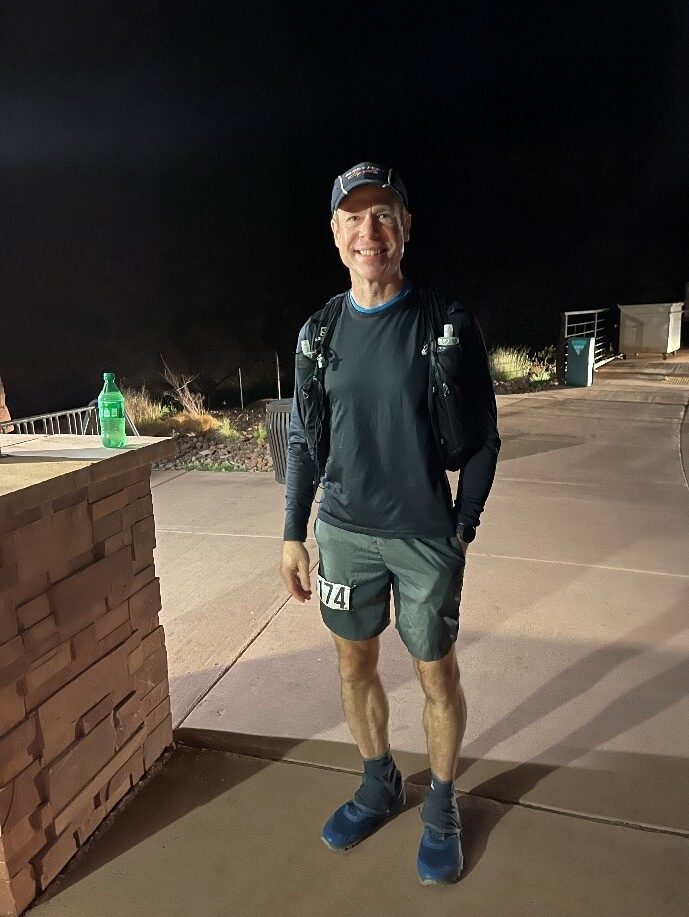
The Beginning – Taking it Easy
The sun hadn’t yet risen over Moab, Utah, but it wouldn’t be long before those first rays of warmth and light would appear above the nearby mesas. I was standing with Heather Mitchell, my lone crew member for the race. Around us, people were chatting, waiting, shifting nervously, or just trying to stay warm. Runners wove through the crowd to use the restroom one last time, or they checked the gear in their packs to ensure nothing had been forgotten. There were a handful of veterans, of course, but there were far more people for whom this would be their first time running more than 100 miles in a single event.
This would be my tenth finish in a 200+ mile footrace, and my fifth finish at the Moab 240, so I knew the course well. The route we would follow included 240 miles of rock and sand and mountains, and even a little bit of pavement. The temperature difference between darkness and daytime would be stark, 60 degrees or more. But all of that was just information, facts. It wouldn’t become real for another few minutes. It wouldn’t become real until all 217 of us toed the line for the 7 AM start.
I was relaxed as I moved to the starting line, saying hi to a few people I knew as I made my way through the assemblage. Looming somewhere in a corner of my mind was the fact that I’d laid awake in bed for most of the night, unable to sleep. When the alarm had finally gone off in the morning, I’d slept for only three hours. Countless miles and hours had gone into my preparation for Moab, yet here I was about to start the race with a disadvantage that no amount of running could have prevented: serious sleep deprivation. In a race that would take me between sixty and seventy hours, this was potentially debilitating. I knew this, but I didn’t allow my mind to linger on it. I brushed the negative thoughts aside as best I could, and instead returned to focusing on the moment. Right now, I felt alert. Right now, I could run.
I started the race like I’d started all of my 200-mile races: cautiously, moving at a controlled pace. I prefer to start near the front of the pack but not at the front of the pack. For me, tenth to twelfth place tends to be a comfortable position for the early portion of a race this long.
The first nine-mile section of the course follows a short series of roads through the town of Moab for a few miles before turning onto a single-track trail that winds below the high mesa looming over the western side of town. This short section was the only time in the entire race when I actually used the GPS functionality of my Garmin watch. I used it not to ensure I was running fast enough, but rather to ensure I was running slowly enough. It’s far too easy to be caught up with other people who begin the race by running faster than I should be running. I think for some people, the choice to run fast so early in the race stems from their excitement and their fresh legs, and sometimes it comes from lack of experience at the distance.
I hit the mile 9 aid station in thirteenth place out of the 217 runners. Of the twelve people ahead of me, there were two I knew personally who were top-tier 200-mile runners. I didn’t doubt those two were running what was a smart pace for them. But there was a good chance some of the other ten people were pushing a little too hard this early in the race. Although I certainly couldn’t know it at the time, of those ten runners, three would finish in the top 10, two would finish farther back in the pack, and five would end up dropping out of the race. Although I would make several mistakes in this race, starting too fast would not be one of them.
By the time I hit the second aid station, Amasa Back, at mile 18, I was in tenth place. Heather had everything ready for me and was waiting beside the dirt road at the entrance to the aid station. After she led me to our crew vehicle, I ate, drank, and then got back on the trail again. I was in and out of there in exactly ten minutes, which was my plan for all of the aid stations as long as I could sustain it. I knew hitting that goal would become increasingly harder the farther I got into the race.
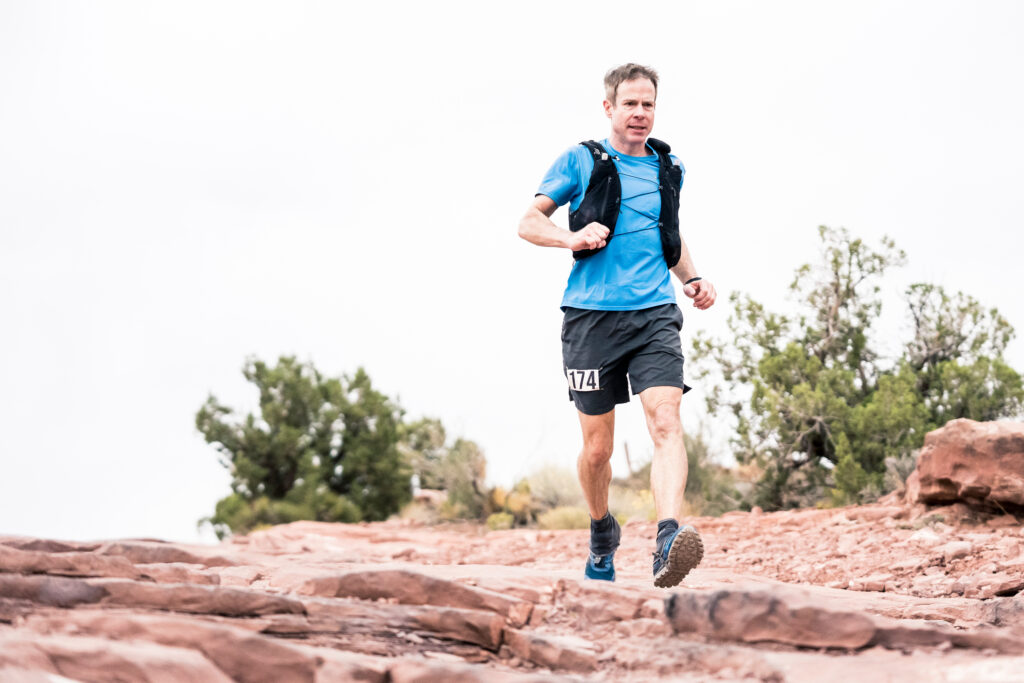
The Valley – Establishing a Position
The next 53 miles of trail consisted of an ascent to the top of a mesa, and then a steep, rocky descent to a long valley that would take the runners all the way to mile 71 where we would next see our crews. I breezed through the mile 33 aid station, Base Camp, in 8 minutes. Then I kept a steady pace as I ran the flat and sometimes gently rolling valley.
Although the first two years I’d run the Moab 240 had been good races for me, the last two years had gone poorly. Between problems with nutrition in 2019, and the unusually high temperatures in 2020, I’d been nauseous throughout eighty miles of the 2019 race and nearly one-hundred miles of the 2020 race. In both instances, my pace during those difficult periods dropped to a lethargic hike, and I vomited virtually every time I tried to eat anything. This year the skies were overcast and a light rain was falling throughout much of the first day, so there was little danger of overheating. I’d also tweaked my nutrition plan to ensure more consistent consumption of calories. So far, things seemed to be falling into place.
Somewhere around mile 48, a foursome of runners became intermittently visible as I wound along the 4×4 road beneath the mesa that defined the valley’s eastern edge. The road twisted and turned into and out of the draws and cracks of the mesa, sometimes offering brief respite from the sun’s draining heat, and sometimes taunting with a shadow that ended fifty feet short of our road.
I gradually drew closer to the foursome, and I was curious who was among them. I knew Annie Hughes was running the race, and from afar I could see someone who I thought might be her. Annie had burst onto the ultrarunning scene earlier in the year with a win at the highly-competitive Leadville 100. It wasn’t until I was almost on top of the group that I realized one of the four was Nathan Williams. Two months earlier, at Bigfoot 200, Nathan had passed me around mile 150, and he’d increased his lead all the way to the finish, taking second place and leaving me in third. I was certain that both Annie and Nathan were going to be tough competition for the rest of the race. Mike Groenewegen was another of the foursome. I knew him from Bigfoot 200 as well. Mike and I had run together near the start of Bigfoot, and then again near the middle. He’d dropped back from me around mile 130 and never regained the lost ground. Regardless, he’d still finished in 9th place at Bigfoot, so I knew that if he was pacing himself well, he would also bring some strong competition to the field.
Annie and I chatted for a while as I ran with the group, but Nathan and I eventually broke slowly away from the others as the pace we were maintaining was just a little faster than what the others seemed to want to do. With Nathan just a short distance ahead of me, this meant I’d moved into 6th place. But I suspected it wouldn’t be the last I’d see of Annie.
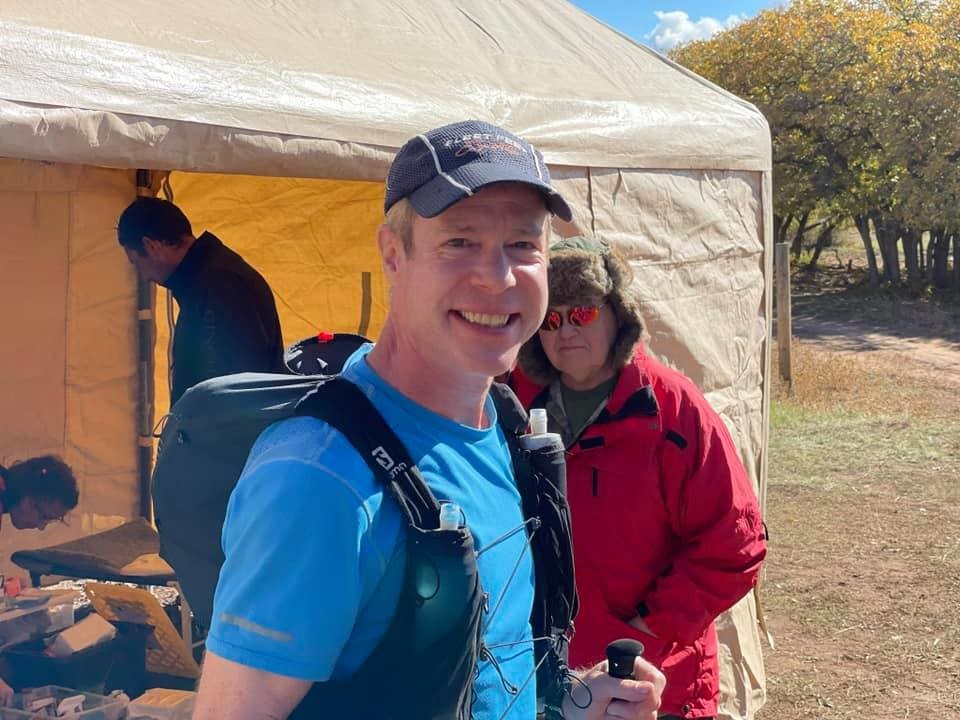
In The Middle – Sleepy
I arrived at the Indian Creek aid station, mile 71, at 9 PM on the first night. I hadn’t seen Heather in the last 53 miles, so seeing her pepped me up. She led me over to the truck where she had a camping chair set up and some potato soup warmed. Exactly ten minutes later she had me up and moving toward the trail. In that short span of time, I’d consumed at least 400 calories, drank extra fluids, and Heather had swapped my pack for a second one that was already full of the critical supplies I’d need to make it another fifty miles without her support.
I was five or six miles out of Indian Creek when the lack of pre-race sleep started biting me. I caught myself moving slower than I should be. My mind was starting to lose focus. I kept pushing ahead, sometimes cranking up music in my earbuds, sometimes just plodding silently through the darkness. But I didn’t stop to sleep. I knew from my experience in 100- and 200-mile races that staying awake through a single night of running was easy if I’d gotten a good night’s sleep before the race. But if I hadn’t slept well, even the first night could be difficult. Regardless, I knew it was always possible one way or another, so I had it in my head that I was not allowed to lie down during the first night of a 200-miler. But, by being too locked into that single idea, I didn’t even consider that lying down for just ten minutes beside the trail might refresh me and allow me to push myself in a way that would more than make up for the loss of ten minutes. This was probably an early mistake on my part.
I reached Shay Mountain aid station, mile 120, at noon on the second day. Heather was waiting patiently for me, and then swung into action as soon as I was in sight. This should have been another ten-minute break for calories, but, at 34 minutes, this would be the second longest aid station stop of the race. I was just so mentally weary. Once I finally got out of the chair and back on the trail again, I was moving lethargically. I walked for almost a mile before transitioning to a slow jog. It wasn’t long before a battle ensued in my mind regarding whether I should lay down in the dirt beside the trail for a 10-minute nap, or whether I should press on. I was concerned I wouldn’t fall asleep, and the time would be wasted. And I was concerned I was just being lazy and weak. I fought it for a while, but, after another mile or two, I realized that every time I passed a spot alongside the trail that would make a good place to stretch out for a nap, I couldn’t help but think about lying down.
Eventually, I stepped off the trail alongside a soft patch of dirt, took off my pack to use as a pillow, and then lay down on my side. Some part of me was still critical of the decision, certain I would lie there without sleeping. Nonetheless, I set the timer on my phone for ten minutes, placed my cap over the side of my face to block the sun, and then closed my eyes. It felt like my alarm was going off only an instant later. I’d slept! I couldn’t believe I’d slept! Suddenly, my assessment of the decision to lay down went from “weak” to “great decision.” Any time I was moving poorly and had reached the point where I could truly fall asleep in a matter of seconds, it meant that my body and mind needed the rest. I put on my pack and started moving forward again. There was a new energy in my step as I ran, and I felt mentally refreshed. It’s amazing what ten minutes of sleep can do.
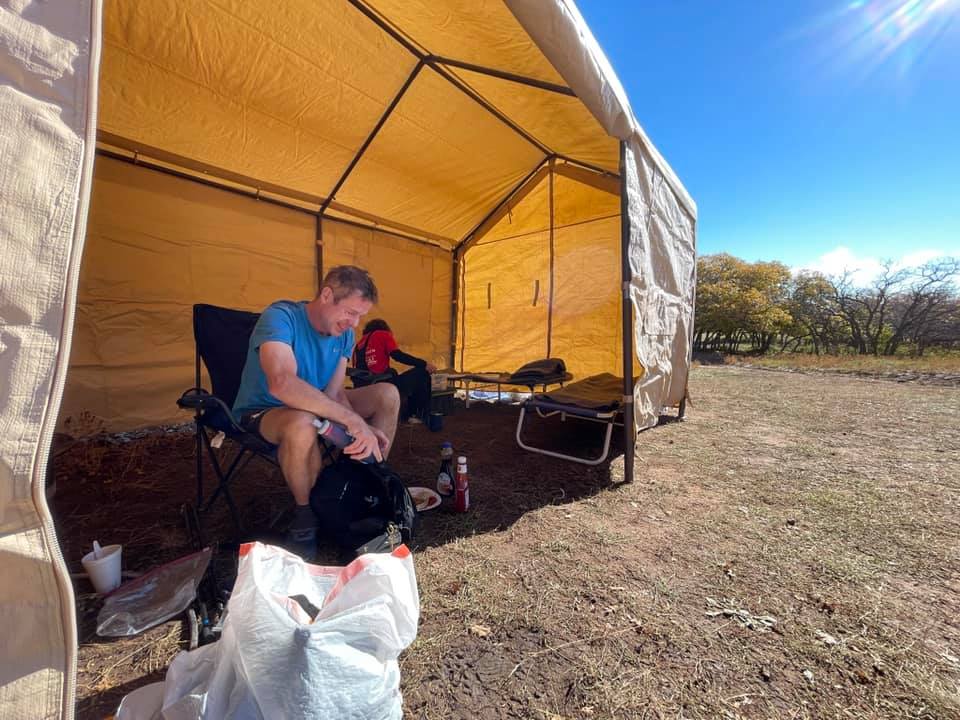
The Flatlands – A Running Partner
Dry Valley aid station sat in the midst of a dusty plain at the bottom of the descent from Shay Mountain. It was the gateway to a 26-mile, flat, dirt road that would bring us ever nearer to the La Sal Mountains. I considered it to be the most boring section of the course, one that I simultaneously liked and hated. I liked the fact that, from an objective standpoint, the miles ticked by quickly since the terrain was eminently runnable. And I hated it because the monotony of the terrain meant that, subjectively, in my mind, those miles passed ever so slowly.
I hadn’t seen Nathan Williams since the encounter with the foursome of runners ninety miles earlier when he had slowly peeled away from me much as he had at mile 150 of Bigfoot two months earlier. But there he was at Dry Valley. He was sitting in a chair with his crew just forward of where Heather had parked her truck to support me. I’d caught up with him. That meant we were now in a collective 5th / 6th place.
A few minutes later, as dusk was arriving, I heard the aid station volunteers cheer, an indicator that Nathan was departing. I took that as my cue to wrap things up and get back on the road again. My pace was by no means aggressive, but I made sure it was fast enough to catch up to Nathan within the first mile or two. For all I know, he might have also chosen to slow down a little in order to have a running partner. Either way, we ended up traveling together. Sometimes we talked, and sometimes we just moved in silence. His long legs set a rapid walking pace that required work for me to keep up with. I knew I should be running this entire 26-mile section, but the three or four times I tried, my mind was so tired that I could push my legs to run only slightly faster than Nathan’s fast walk. Eventually, I gave up and just walked with him. Nighttime in the desert was always cold this time of year, and this night was no exception. I bundled up in layers and put on a stocking cap to replace the ball cap I’d removed.
Other than missing an obvious turn, the 26-mile section was uneventful up until a few miles out from Road 46 aid station. It was around midnight of the second night, and the sleep deprivation was hitting me hard. Several times I caught myself weaving as I walked up the road. Then, a glow of light from behind caused me to glance back. I saw several lights, two of which appeared to be at a height that would be headlight-level of a truck. Two other lights were higher, and I concluded they were the kind of roof-mounted lights I’d sometimes seen on 4 x 4 trucks. The truck appeared to be slowly following us, which made no sense to my addled mind.
“Why is that truck following us?” I asked Nathan.
“That’s Annie and her pacer,” he said.
I looked back again. He was right. Between my weaving and my inability to distinguish a pair of runners from a truck, I knew I needed to sleep when I got to Road 46. I decided an hour of sleep would be enough to get me through the rest of the race. Or maybe an hour twenty.
Annie passed us at a good clip. She was clearly feeling stronger than either Nathan or I. I tried to keep pace with her for a few hundred yards up a hill, but decided it was futile and dropped back to rejoin Nathan.
Nathan had been feeling poorly for a while. In fact, he was feeling bad enough that he was even considering dropping out of the race at the Road 46 aid station. We kept moving at Nathan’s rapid walking pace until we were only a short distance from the aid station. Again, he mentioned that he thought he was going to drop out of the race. I hated to see anyone drop, even if they were a competitor who might beat me, and so I commented that it was a long race and there was lots of time to recover from just about anything. He said he planned on talking it over with his crew and getting some sleep before making a decision. But, from the tone of his voice, I didn’t have a lot of confidence he was going to continue the race. It was 1:40 AM when we walked into the aid station. We wished each other good luck and split off to our respective crews.
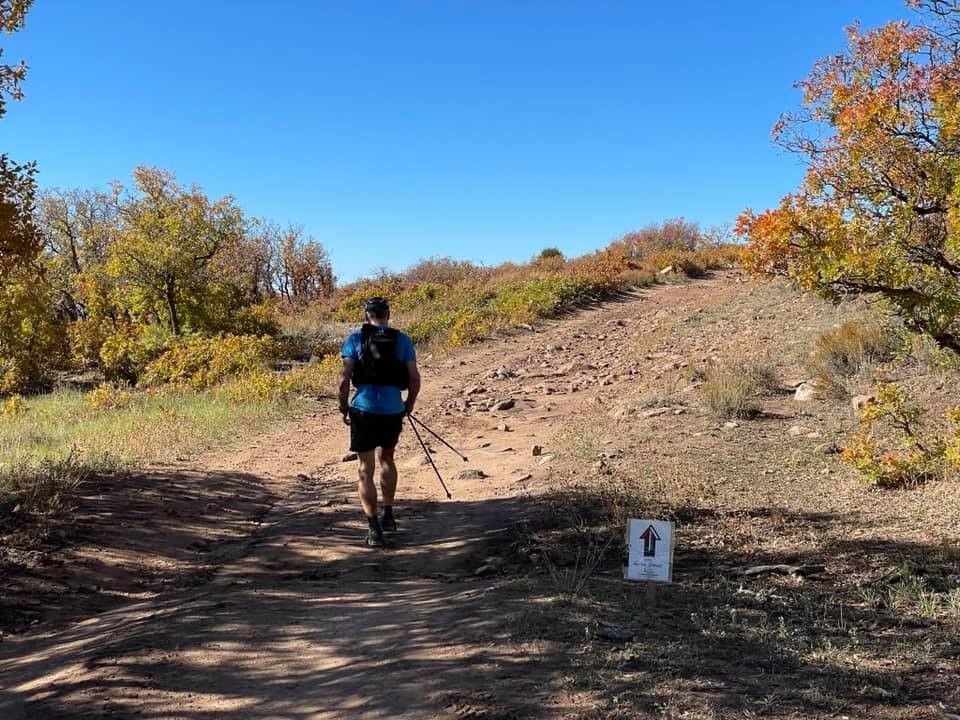
Road 46 – Sleep at Last
Road 46 aid station was a long stop, as I knew it needed to be. Clocking in at 150 minutes, almost half of my total aid station time during the race would be spent at Road 46. After checking in with the volunteers, I climbed into the front passenger seat of Heather’s truck and ate what Heather had ready for me. It was too cold to sleep outside even with blankets, so, after eating, I made myself as comfortable as I could in the front seat. Heather set a timer for an hour and twenty minutes, and we both closed our eyes. It took a little while, but I did fall asleep. Unfortunately, my inability to get comfortable meant that I woke up, shifted position and then fell back asleep no less than a dozen times during that period. A solid block of sleep would have been much better, but the alarm’s buzz was my signal that the time for rest was done.
When I left Road 46 to head for the La Sal Mountains, I didn’t know if anyone else had come through the aid station during the time Heather and I were sleeping. And, if Nathan had dropped or hadn’t yet departed the station, I might have been in 5th place. Unfortunately, even if no one had passed me in the aid station, my extended stop gave everyone behind me a good opportunity to close the gap between us. Right now, this was all just speculation regarding what the situation might be, but soon I would learn that these fears were not unfounded.
The route from Road 46 to Pole Canyon included 2500 feet of cumulative elevation gain, much of which was in the form of a gentle ascent throughout the middle section and then some steeper rollers during the latter portion. Three times during the first half of the section I actually curled up on the side of the trail to see if I could fall asleep again. I wasn’t thinking clearly, or I would have known I was merely wasting time. In all three instances, I got back to my feet after four or five minutes, unhappy with myself for even attempting to sleep. Behind me, every time I stopped, unseen runners drew nearer to me. Ahead, runners were pulling farther away.
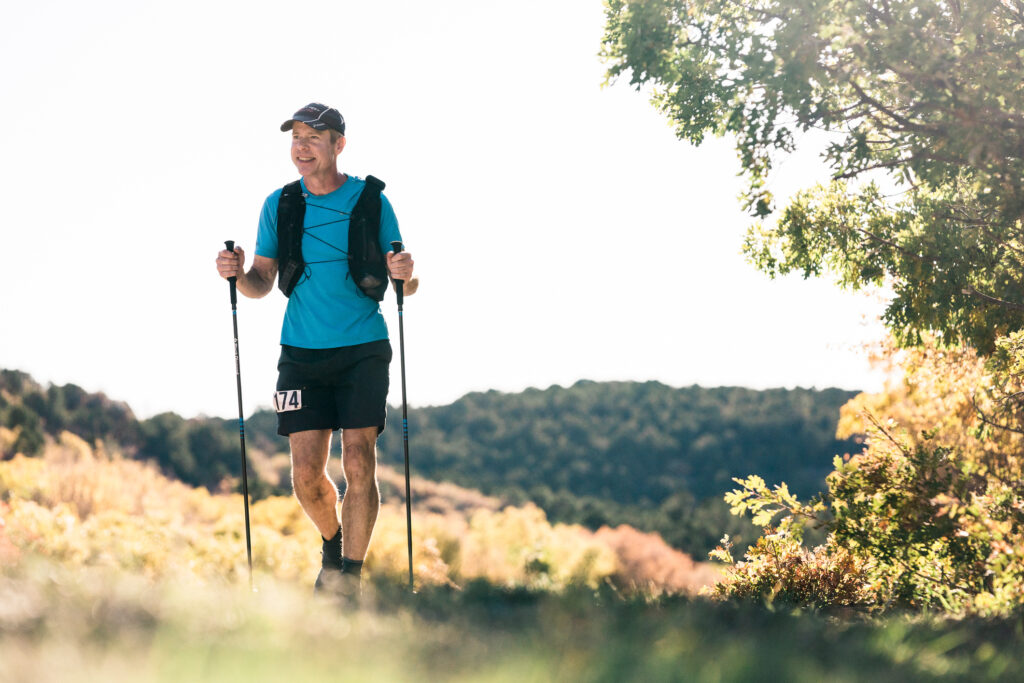
The Snow Route – Playing Defense
Due to the danger of heavy snow in the La Sal Mountains, the evening before the race a decision had been made to re-route a portion of the course to avoid the higher elevations in the mountains. This resulted in the last four miles to Pole Canyon aid station becoming an out-and-back just as it had been in 2018, the only other year there had been a snow re-route. This meant that runners departing Pole Canyon would repeat the same four miles they’d just run to get there. More importantly, it meant that each runner crossed paths with every other runner who was within eight miles ahead of or behind them.
I was a mile and a half along that out-and-back heading toward Pole Canyon when I saw someone who I didn’t recognize running the opposite direction. I realized it was someone who must have passed me while I was sleeping at Road 46, and our relative positions along the out-and-back meant he was five miles ahead of me with 52 miles to the finish. I later learned it was Robert Mueller, a runner I’d never met. By passing me at Road 46 he’d bumped me into 6th place. And if Robert was 5 miles ahead of me, how much farther ahead was Annie? Simple math told me she was at least 8 miles ahead since I hadn’t seen her on the out-and-back.
I tried to be efficient at the aid station, but the next section was 24 miles so it was important that I get some calories into my body. Lori Enlow and Wes Plate, two runners I knew from a previous iteration of Moab 240, were among the team of volunteers at the aid station, and they got me everything I needed so I could get out of there quickly. I’d just stood up to leave, and was strapping my pack across my shoulders when a couple whoops from the volunteers caused me to look up. Blasting down the small hill into Pole Canyon were two runners.
The taller of the two runners was Nathan. His mood and his energy were a complete turnaround from when I’d last seen him in the dark hours before Road 46 aid station. I cheered him on for making what had probably been a tough decision to continue, and for his tremendous recovery. I didn’t recognize the other runner, but he too seemed to be going strong.
Despite my genuine happiness for Nathan, I realized I was in a very tenuous 6th place. Nathan and the other runner were only as far behind me as the time they took at the aid station. If they kept their stop brief, they could easily be within a mile of me. As I made my way back along the 4-mile out-and back, I crossed paths with individual runners four more times, exacerbating my feeling of being chased. The thought of narrowing Robert Mueller’s 5-mile lead faded from my mind. Now I just wanted to hang onto 6th place.
We’ve all heard that it’s best to run your own race, pacing yourself based on what you feel you are capable of doing rather than what others around you are doing. This is a sound strategy that helps prevent a number of mistakes such as pacing yourself too fast, which can result in a catastrophic blow-up later in the race. But a single strategy doesn’t fit every situation. If you’re trying to be competitive, there often comes a time when you need to take into account what others around you are doing. There comes a time when you need to adjust your own actions in an effort to perform better relative to the other competitors. That time came for me after my departure from Pole Canyon. My strategy shifted. I went from purely running my own race to intentionally driving myself harder as a means to maintain my position in 6th place. This was a defensive strategy. I didn’t think I could catch Robert or Annie or the three runners ahead of them. At that point, I’d essentially been in 6th place for the last 135 miles, and I wasn’t feeling any confidence I could improve that position. But I knew that I could lose it to one or more of the people behind me if I didn’t start moving faster, regardless of any risk of blowing up.
I didn’t push myself foolishly hard, but my effort level went up noticeably, and my body seemed to be able to handle it. The re-routed section offered some light bushwhacking, a couple uphill stretches, and then a long downhill unpaved road section. That road was covered entirely in fist-sized rocks which required diligent foot placement every step of the way to avoid a rolled ankle. The section ended with a long ascent up a paved road to Horse Creek aid station. The road offered some views overlooking a small portion of the route I’d just descended, and I checked several times to see if anyone was coming down it. I didn’t see any runners, which gave me comfort that Nathan and the guy who had been running with him were at least not right on my tail.
Waiting for me at Horse Creek aid station were Heather and, to my surprise, Eric Quallen. Eric was a friend of mine who’d paced me for 100 miles at Moab in 2020, and he’d been running Moab this year as a competitor before he was pulled from the race for medical reasons at the third aid station. To have him there unexpectedly supporting me along with Heather was a big pick-up this late in the race and would provide further benefits a few hours later.
No runners arrived at Horse Creek during my stop, which was a relief to me. I started running as soon as I left the aid station, enjoying the brief but smooth descent that began the 12-mile route to Porcupine Rim. Although this section had a bit of vertical gain, it was entirely on a mix of dirt and paved roads; easy going compared to the last section. Still lurking at the back of my mind was the fear of being passed by the runners behind me. That fear kept me pushing steadily, but I knew the 240-mile distance well enough that I managed my pace at a level I felt I could sustain for another thirty miles.
Porcupine Rim – Time to be Offensive
When I hit Porcupine Rim aid station it was almost 9 PM. Night had fallen. Heather was going to pace me for the last section, so she already had her pack ready. Eric was there to help speed me through the station, and to drive our truck to the finish line. I took in enough calories for the final miles, and was out of there in nine minutes, just under the goal time. More importantly, Heather and Eric let me know that Annie had departed Porcupine Rim ninety minutes before my arrival, and Robert had left an hour after Annie. On the surface that sounded like they both had a big lead on me, but the way I was feeling it didn’t seem insurmountable. My strategy changed again. I was no longer worried about escaping from the runners behind me. Instead, I shifted to an offensive mindset. I was going on the attack. I had the strength, I had the energy, and I was more alert and more focused than I’d been in the preceding twenty hours. I was going to catch Robert, and, after that, I’d see what I could do next. It was time to fly.
And fly we did—at least as much as a person with 222 miles on his legs can fly. I took the lead and Heather followed right behind me. We ran two miles down a dirt road to the single-track turnoff that had been the location of Porcupine Rim aid station during the previous four iterations of the race. After the turn, there were a number of short, rocky ascents, and then the remaining 10 or 12 miles of the trail to the bike tunnel were technical but very runnable, and almost entirely downhill.
Heather’s powerful Kogalla lights brightened the rocky, technical trail ahead of me as we descended, allowing me to run even faster than I might have with only my own lights. I’d run this section of the course four times in races and another couple times in years past when I’d done it to preview the route. There was no section of the course that I knew better than this one. This was my opportunity if only I could seize it.
Eric had driven down to the finish line in the meantime, and was watching the online live race tracker. At some point early in the section, Heather got a text from Eric with an update: Robert had passed Annie, and I was quickly gaining on Annie. That message reinforced my belief that I had a chance to catch them.
I was so focused on the details of the trail and on pushing my speed to the limit of what I could sustain that there were essentially no conscious thoughts in my mind. My eyes were simply scanning the rocks and the uneven ground, and my feet responded by landing in the right place again and again and again. I didn’t think of the finish line. I didn’t think of Annie or of Robert. I simply ran, and that task constituted the entirety of my existence. It was a meditation.
We passed Annie two hours after leaving the aid station, calling out a greeting as we went by. Then my mind and body were once again fully focused on nothing more than forward movement. We came upon Robert and his pacer thirty minutes later, and again we called out as we ran by.
I couldn’t back off at this point. I had to widen the gap or I’d be giving Robert an opportunity to catch me. I kept pushing.
A little while later Eric texted Heather that Robert had sped up, but a solid gap had grown between us. Heather and I came off the last of the single-track and passed through the bicycle tunnel to the other side of the highway along the Colorado River. It was three miles of flat bike path from here to the finish. With the gap that Eric had described, it was unlikely that Robert could catch me, but I wasn’t taking chances. Although my body wanted nothing more than to slow down, I couldn’t let it do that. With only 3 miles to go, I pushed my body as hard as I possibly could. Sustainability wasn’t a concern anymore. I would force my body to sustain. And I was no longer moving unconsciously through the landscape. Instead, I was focusing my mind on my breathing because it was better than thinking about the pain that coursed through my legs with every stride. Breathing was merely a rhythm. It was easier to push a rhythm than to push pain. I was still living completely in the moment, but now that moment consisted only of this: breathe in, exhale, breathe in, exhale, breathe in, exhale.
Fifty Yards of Pavement – The Finish
I stopped 100 yards short of the finish line, just below the crest of a tiny rise.
Eric walked over from where he’d been standing. He’d run a portion of the race, volunteered at Wind Whistle aid station, helped Heather crew me for the last two aid stations, and here he was welcoming me at 1 AM when he probably wanted to be sleeping.
Somewhere along the bike path, Heather had dropped back a bit. She’d supported me through this entire endeavor, and we needed to finish this together. She came up the hill just a couple minutes later, and together we crossed the finish line.
I’d finished in 4th place overall with a time of 67 hours, 12 minutes. Robert took fifth place in 67:49. Nathan finished sixth with a time of 68:42. Annie was the first female finisher, and finished seventh overall with a time of 68:50. I was 53 years old at the time of the race. The other nine of the top ten finishers averaged 35 years old, with the oldest being 43.
The run from Porcupine Rim Aid Station to the finish is the most memorable finishing section in any of the eleven 200+ mile races I’ve run. In some of my past 200-milers I’ve placed better than I did at 2021’s Moab 240, but in none of those better finishes did I have to push myself as hard at the end as I did for the last 18 miles of this race. It answered a question that had nagged me for a long time, but for which I’d never found the answer: would I be capable of pushing myself to the brink after so many miles on the trail? It was not a question of physical capability. It was a question of whether my mind would step up to the task of pushing my body through the pain, or whether my mind would give in and take the easy path of letting opportunity slip by. At Moab this year, I finally found the answer to that question. And I was happy with the answer I found.
See you on the trails!
Wes Ritner
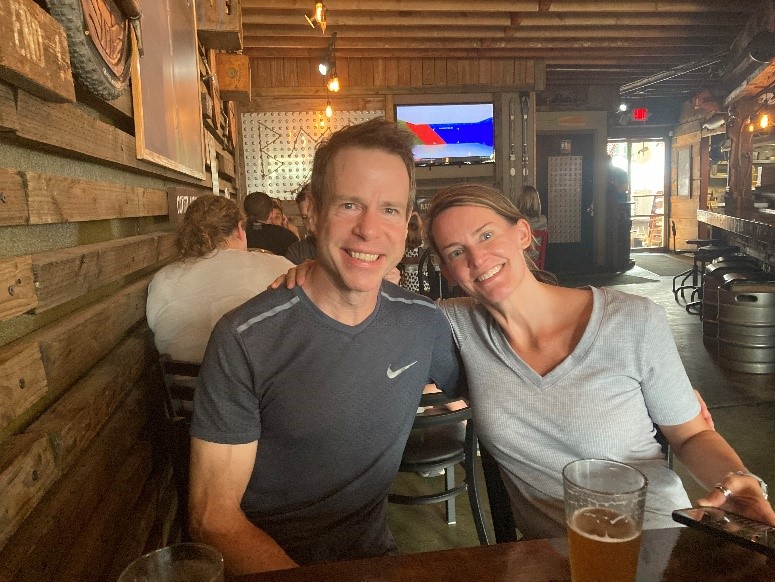
Heather and I celebrating. Don’t tell anyone, but this photo was actually taken two months before Moab after Bigfoot 200. Sorry, I couldn’t find a decent post-race photo from Moab.